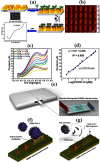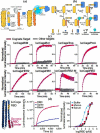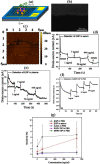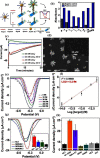Recent Advances in Biosensors for Detection of COVID-19 and Other Viruses
- PMID: 36197867
- PMCID: PMC10009816
- DOI: 10.1109/RBME.2022.3212038
Recent Advances in Biosensors for Detection of COVID-19 and Other Viruses
Abstract
This century has introduced very deadly, dangerous, and infectious diseases to humankind such as the influenza virus, Ebola virus, Zika virus, and the most infectious SARS-CoV-2 commonly known as COVID-19 and have caused epidemics and pandemics across the globe. For some of these diseases, proper medications, and vaccinations are missing and the early detection of these viruses will be critical to saving the patients. And even the vaccines are available for COVID-19, the new variants of COVID-19 such as Delta, and Omicron are spreading at large. The available virus detection techniques take a long time, are costly, and complex and some of them generates false negative or false positive that might cost patients their lives. The biosensor technique is one of the best qualified to address this difficult challenge. In this systematic review, we have summarized recent advancements in biosensor-based detection of these pandemic viruses including COVID-19. Biosensors are emerging as efficient and economical analytical diagnostic instruments for early-stage illness detection. They are highly suitable for applications related to healthcare, wearable electronics, safety, environment, military, and agriculture. We strongly believe that these insights will aid in the study and development of a new generation of adaptable virus biosensors for fellow researchers.
Figures






Similar articles
-
Recent Developments in Electrochemical-Impedimetric Biosensors for Virus Detection.Int J Mol Sci. 2022 Dec 14;23(24):15922. doi: 10.3390/ijms232415922. Int J Mol Sci. 2022. PMID: 36555560 Free PMC article. Review.
-
Recent Progress in Graphene- and Related Carbon-Nanomaterial-based Electrochemical Biosensors for Early Disease Detection.ACS Biomater Sci Eng. 2022 Mar 14;8(3):964-1000. doi: 10.1021/acsbiomaterials.1c00710. Epub 2022 Mar 1. ACS Biomater Sci Eng. 2022. PMID: 35229605 Review.
-
Electrochemical detection of Zika and Dengue infections using a single chip.Biosens Bioelectron. 2022 Nov 15;216:114630. doi: 10.1016/j.bios.2022.114630. Epub 2022 Aug 17. Biosens Bioelectron. 2022. PMID: 36007411
-
A Review of THz Technologies for Rapid Sensing and Detection of Viruses including SARS-CoV-2.Biosensors (Basel). 2021 Sep 22;11(10):349. doi: 10.3390/bios11100349. Biosensors (Basel). 2021. PMID: 34677305 Free PMC article. Review.
-
SARS-CoV-2-Impedimetric Biosensor: Virus-Imprinted Chips for Early and Rapid Diagnosis.ACS Sens. 2021 Nov 26;6(11):4098-4107. doi: 10.1021/acssensors.1c01614. Epub 2021 Nov 10. ACS Sens. 2021. PMID: 34757734
Cited by
-
Design of highly sensitive biosensors using hollow-core microstructured fibers for plasma sensing in aids with human metabolism.Opt Quantum Electron. 2023;55(2):188. doi: 10.1007/s11082-022-04514-w. Epub 2023 Jan 4. Opt Quantum Electron. 2023. PMID: 36618531 Free PMC article.
-
Climate change, its impact on emerging infectious diseases and new technologies to combat the challenge.Emerg Microbes Infect. 2024 Dec;13(1):2356143. doi: 10.1080/22221751.2024.2356143. Epub 2024 May 29. Emerg Microbes Infect. 2024. PMID: 38767202 Free PMC article. Review.
-
Determinants of influenza and COVID-19 vaccine intent or uptake in Lebanon: a scoping review of the literature.BMC Infect Dis. 2023 Aug 6;23(1):511. doi: 10.1186/s12879-023-08478-4. BMC Infect Dis. 2023. PMID: 37544988 Free PMC article.
-
Development and Analytical Evaluation of a Point-of-Care Electrochemical Biosensor for Rapid and Accurate SARS-CoV-2 Detection.Sensors (Basel). 2023 Sep 20;23(18):8000. doi: 10.3390/s23188000. Sensors (Basel). 2023. PMID: 37766054 Free PMC article.
-
A label-free nanowell-based impedance sensor for ten-minute SARS-CoV-2 detection.Sens Diagn. 2025 Apr 30;4(6):511-518. doi: 10.1039/d5sd00002e. eCollection 2025 Jun 12. Sens Diagn. 2025. PMID: 40352677 Free PMC article.
References
Publication types
MeSH terms
LinkOut - more resources
Full Text Sources
Medical
Miscellaneous

